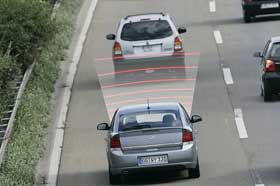General Motors plans to build a vehicle which automatically stays in lane and will not crash into the back of the car in front. The technology should be fitted to the Vectra range by 2010.
Laser sensors and video cameras will automatically correct the steering if the driver veers to one side, and also keep the car at a constant distance from the vehicle ahead when driving on busy, urban roads.

Sensors are mounted in the headlights and bumper, with a video camera built into the rear-view mirror mounting. There are even long-range LIDAR sensors to detect weather conditions which reduce visibility, such as fog and snow.
The driver can programme the car to remain a set distance from the vehicle in front. Information from the sensors and camera will automatically adjusts the car’s speed and braking. The camera detects markings on lanes and at the edges of the road, enabling the car’s steering to also be corrected so drivers stay in lane.
Sue Nicholson, at RAC Foundation, said: “Our only reservation would be if there was an over-reliance on it or complacency by drivers.” She added that such equipment could pose a legal minefield if there was an accident: “If a collision and/or injury were to occur while the system were operating, is the driver or system responsible?”
But most of the technology GM is promoting is already available in showrooms – though not yet all in the same car.
At Citroën: should the car stray left out of a motorway lane, the seat bolster will vibrate your left buttock – or your right buttock should you veer right – because the seat mechanism is linked to infrared cameras under the bumper which recognise white lines. With Mercedes Benz saloon’s Distronic system, your car will speed up and slow down automatically in motorway traffic to ensure you can never crash into the car in front and in January, Honda’s new Accord will link both technologies.
Via Scotsman, The Economist. Picture from Netzeitung.
